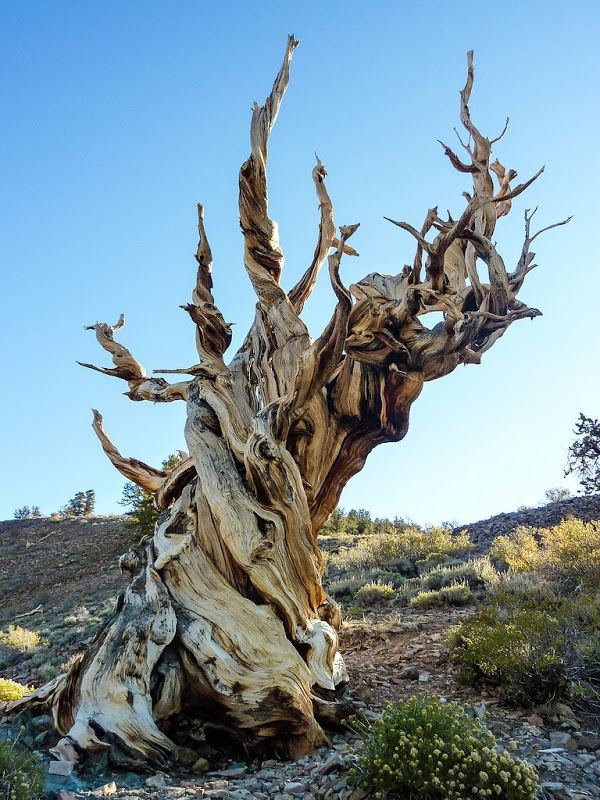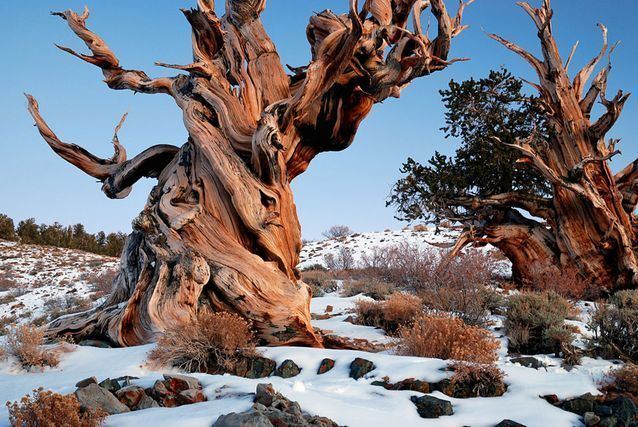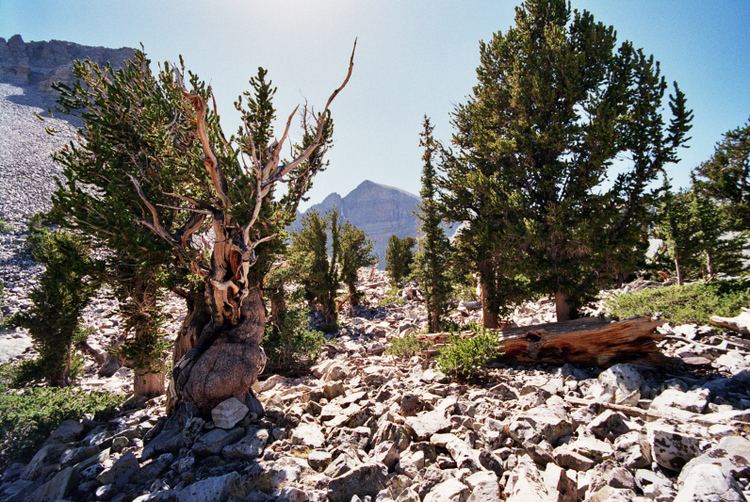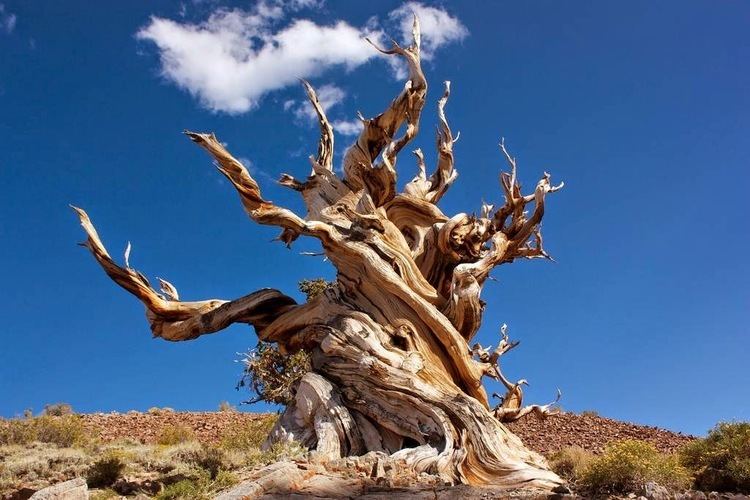Class Pinopsida Scientific name Balfourianae | Division Pinophyta Genus Pinus Rank Subsection | |
 | ||
Similar | ||
Bristlecone pine tree ranger minute
A bristlecone pine is one of three species of pine trees (family Pinaceae, genus Pinus, subsection Balfourianae). All three species are long-lived and highly resilient to harsh weather and bad soils. One of the three species, Pinus longaeva, is among the longest-lived life forms on Earth. The oldest Pinus longaeva is more than 5,000 years old, making it the oldest known individual of any species.
Contents
- Bristlecone pine tree ranger minute
- Hugh prestwood s bristlecone pine sung by j salestrom
- Species and range
- Description
- Oldest living organisms
- References

Despite their potential age and low reproductive rate, bristlecone pines, particularly Pinus longaeva, are usually a first-succession species, tending to occupy new open ground. They generally compete poorly in less-than-harsh environments, making them hard to cultivate. In gardens, they succumb quickly to root rot. They do very well, however, where most other plants cannot even grow, such as in rocky dolomitic soils in areas with virtually no rainfall.

Bristlecone pines grow in scattered subalpine groves at high altitude in arid regions of the Western United States. The name comes from the prickles on the female cones.

Hugh prestwood s bristlecone pine sung by j salestrom
Species and range
There are three closely related species of bristlecone pines:


At least some of the three species can hybridize in cultivation, but the ranges of wild populations do not overlap. The Colorado River and Green River produces a 160-mile (260 km) gap between the ranges of P. longaeva and P. aristata and the northern Owens Valley provides a 19-mile (30 km) gap between the ranges of P. longaeva and P. balfouriana.
Description
Bristlecone pines grow in isolated groves just below the tree line, between 5,600 and 11,200 ft (1,700 and 3,400 m) elevation on dolomitic soils. The trees grow in soils that are shallow lithosols, usually derived from dolomite and sometimes limestone, and occasionally sandstone or quartzite soils. Dolomite soils are alkaline, high in calcium and magnesium, and low in phosphorus. Those factors tend to exclude other plant species, allowing bristlecones to thrive. Because of cold temperatures, dry soils, high winds, and short growing seasons, the trees grow very slowly. Even the tree's needles, which grow in bunches of five, can remain on the tree for forty years, which gives the tree's terminal branches the unique appearance of a long bottle brush.
The bristlecone pine's root system is mostly composed of highly branched, shallow roots, while a few large, branching roots provide structural support. The bristlecone pine is extremely drought tolerant due to its branched shallow root system, its waxy needles, and thick needle cuticles that aid in water retention.
The wood is very dense and resinous, and thus resistant to invasion by insects, fungi, and other potential pests. The tree's longevity is due in part to the wood's extreme durability. While other species of trees that grow nearby suffer rot, bare bristlecone pines can endure, even after death, often still standing on their roots, for many centuries. Rather than rot, exposed wood, on living and dead trees, erodes like stone due to wind, rain, and freezing, which creates unusual forms and shapes.
The bristlecone pine has an intrinsically low rate of reproduction and regeneration, and it is thought that under present climatic and environmental conditions the rate of regeneration may be insufficient to sustain its population. The species are on the International Union for Conservation of Nature (IUCN) red list. The species are labeled under Least Concern (LC). The justification for this being that no subpopulations for Great Basin bristlecone pines are decreasing. Subpopulations seem to be increasing or remaining stable. Many bristlecone pine habitats have been protected, including the Inyo National Forest's Ancient Bristlecone Pine Forest in the White Mountains of California and the Great Basin National Park in Nevada, where cutting or gathering wood is prohibited.
The green pine needles give the twisted branches a bottle-brush appearance. The needles of the tree surround the branch an extent of about one foot near the tip of the limb. The name bristlecone pine refers to the dark purple female cones that bear incurved prickles on their surface. The dark color of these cones help to absorb heat. After maturity, which takes about two years, the cones will become brown in color. These ancient trees have a gnarled and stunted appearance, especially those found at high altitudes, and have reddish-brown bark with deep fissures. As the tree ages, much of its vascular cambium layer may die. In very old specimens, often only a narrow strip of living tissue connects the roots to a handful of live branches. Even though the trees needles may age, they still remain functional in regulating water and by their ability to photosynthesize.
Oldest living organisms
Bristlecone pines are known for attaining great ages. A specimen of Pinus longaeva located in the White Mountains of California is 7003506600000000000♠5,066 years old according to measurements by Tom Harlan. This is the oldest known individual tree in the world. The identity of the specimen is being kept secret by Harlan. Another well-known bristlecone from the White Mountains is Methuselah which is 7003484800000000000♠4,848 years old. Its specific location is also being kept secret.
The other two species, Pinus balfouriana and Pinus aristata are also long-lived, though not to the extreme extent of P. longaeva; specimens of both have been measured or estimated to be up to 3,000 years old. It is believed that the longevity of the trees is related to the proportion of dead wood to live wood. This high ratio reduces respiration and water loss, thereby extending the life of the tree.
Note that trees that reproduce via cloning can be considered to be much older than bristlecone pines. A colony of 47,000 quaking aspen trees (nicknamed "Pando"), covering 106 acres (43 ha) in the Fishlake National Forest of the United States, has been estimated to be 80,000 years old, although tree ring samples date individual, above-ground, trees at only an average of about 130 years.
The bristlecone pine is invaluable to dendroclimatologists, because it provides the longest continual climatically sensitive tree-ring chronologies on the planet. By cross-dating millennia-old bristlecone pine debris, some chronologies reach beyond 9,000 years before present. In addition, ratios of stable carbon isotopes from bristlecone pine tree rings are sensitive to past variations in moisture availability. This information can be used to reconstruct precipitation changes in the past.
The Rocky Mountain population is severely threatened by an introduced fungal disease known as white pine blister rust, and by pine beetles. Another problem that the species face is climate change as temperatures have increased 0.5–1 °C within the past 30 years throughout the southern Rocky Mountain range. These changes in climate would mostly affect trees in higher elevations. With these problems, the genetic diversity within the species has become a concern. It is noted that old specimens have, however, survived previous warmer periods.
